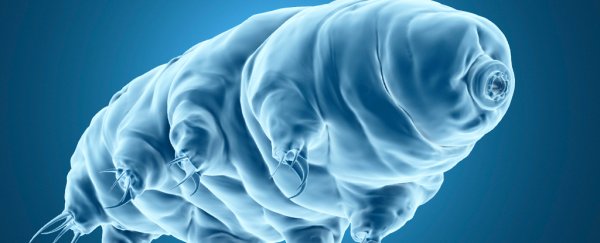Radiation that would reduce the DNA inside our own cells into genetic confetti is no match for the microscopic tough-guy known as a tardigrade, and we just got closer to understanding just how these critters are so tough.
Their protection works in part due to the shielding provided by a special 'damage suppression' protein called Dsup. Exactly how this molecular armour provides protection isn't all that clear; now, a computerised model of the protein interacting with DNA could provide a starting place.
Tardigrades - affectionately known as 'water bears' or even 'moss piglets' - are a phylum of worm-like animals famous for their robust physiology. Their talents include vitrifying their gooey bits to avoid damage from drying out, chilling comfortably in a vacuum, and hibernating while the world goes to hell.
We've known about Dsup's potential in shielding DNA for a few years now, having put it through its paces in a variety of experiments.
Slipped into a culture of human cells, for example, the protein reduces the destruction caused by a dose of X-rays by around 40 percent. It also seems to do a more than adequate job of protecting DNA against the corrosive effects of hydroxyl radicals.
Somehow, by latching onto strands of nucleic acid, the protein deflects or absorbs nasty elements that would otherwise lay waste in the living cell.
In search of more clues, a team of researchers from the Polytechnic University of Madrid's Centre for Plant Biotechnology and Genomics have now used genetic sequences from the tardigrade Ramazzottius varieornatus to predict the arrangement of Dsup's amino acid components.
For something to compare it against, they also developed a similar model for another protein that was a relatively near match for Dsup, one found in a second tardigrade species called Hypsibius exemplaris.
From there, it was a matter of digitally combining each protein with a model of DNA and comparing the resulting complexes with individual components sitting on their own.
This isn't to imply the task was in any way simple – calculating the activity of a pair of Dsup proteins with a computerised model of even a small chunk of DNA demanded mapping hundreds of thousands of digital atoms, pushing supercomputer technology to its absolute limits.
The results revealed particularly messy sections of the Dsup protein could bend to conform to the structure of DNA, adapting its shape to fit over an underlying sequence - like a molecular suit of armour.
"Our results suggest that the protein is intrinsically disordered, which enables Dsup to adjust its structure to fit DNA shape," the researchers write in their report.
This unique degree of disorder and flexibility implies there's something about the electrostatic interactions between the two molecules that provides it with its uncanny shielding talent.
It's not unreasonable to imagine the protein could act as something of a genetic exoskeleton, shielding and supporting at the same time.
Any specifics on how radiation affects the protein on a physical level will need to be worked out in future experiments, but the disordered nature of Dsup and its ability to warp into a protective conformation is already a significant piece of the puzzle.
Not only is this protein useful when it comes to understanding the death-defying talents of tardigrades, it could help point the way to manufacturing protective coatings for pharmaceuticals, if not bestow radiation-protection on our own bodies.
If we're to ever deal with the hazards of space travel ourselves, we might want a trick or two up our sleeves when it comes to coping with high doses of radiation.
Sunscreen for our DNA is best left to science fiction for now, though. We still don't know how Dsup evolved, or even what other effects it might have in the tardigrade's body. After all, this is one weird little beastie.
This research was published in Scientific Reports.
